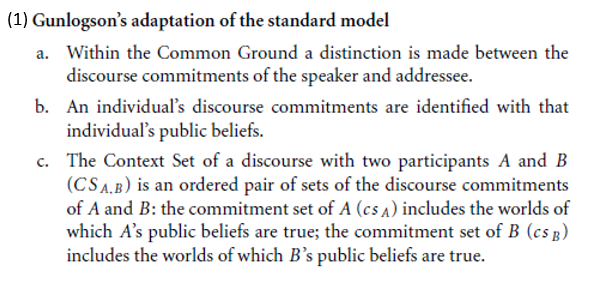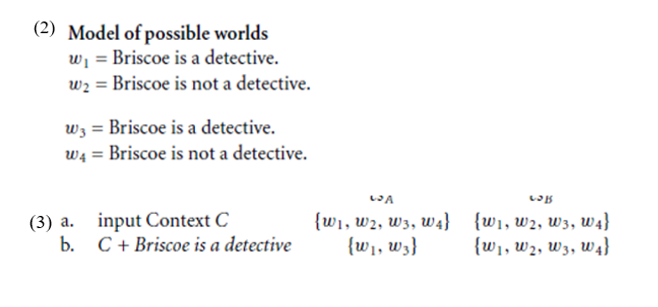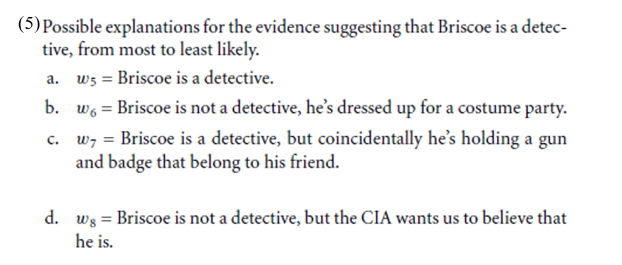


 Grammar
Grammar
 Tenses
Tenses
 Present
Present
 Past
Past
 Future
Future
 Parts Of Speech
Parts Of Speech
 Nouns
Nouns
 Verbs
Verbs
 Adverbs
Adverbs
 Adjectives
Adjectives
 Pronouns
Pronouns
 Pre Position
Pre Position
 Preposition by function
Preposition by function 
 Preposition by construction
Preposition by construction
 Conjunctions
Conjunctions
 Interjections
Interjections
 Grammar Rules
Grammar Rules
 Linguistics
Linguistics
 Semantics
Semantics
 Pragmatics
Pragmatics
 Reading Comprehension
Reading Comprehension
 Teaching Methods
Teaching Methods| A case study of the semantics of clear - The framework – a version of Gunlogsons model of context update |
|
|
|
Read More
Date: 2024-01-19
Date: 2024-01-20
Date: 2025-04-12
|
A case study of the semantics of clear - The framework – a version of Gunlogsons model of context update
The starting point for the analysis of discourse adjectives is Gunlogson’s 2001 version of a standard Stalnakerian model of context update. The basic idea of Gunlogson’s model is outlined in (1).

The context as defined in (1c) represents a departure from more standard implementations of a Stalnakerian model. Gunlogson takes the distinct discourse commitments of individual participants to be basic, and she uses this to derive a standard Stalnakerian context set. This isn’t to say that one cannot derive the individual commitments from the standard Stalnakerian conception of the context of a discourse, but in order to talk about discourse adjectives, access to individual commitments is crucial. Gunlogson’s model is a natural choice for the ease of exposition.
An example of the effect an utterance of Briscoe is a detective has on the common ground is shown in (3). The model of possible worlds under consideration is given in (2). The context set in (3) separates the commitment sets (the worlds consistent with the public beliefs) of A and B.

In (3a) all of the worlds in the model in (2) are included as live options for both A and B. Update with A’s assertion of Briscoe is a detective removes w2 and w4, worlds in which Briscoe is not a detective, from A’s individual commitment set. The context in (3b) is biased toward the truth of the proposition expressed by Briscoe is a detective. Bias is a technical term introduced by Gunlogson, to contrast with the notion of contextual neutrality. Definitions of contextual bias and neutrality are provided in (4).

By these definitions, before A’s utterance of Briscoe is a detective, the context in (3a) is neutral with respect to the proposition expressed. The effect of the utterance is a context that is biased toward the proposition expressed by Briscoe is a detective.
With this terminology established, it is possible to proceed with an analysis of clear. The starting point is the convergence of three observations about discourse adjectives: first, that they are not factive; second, that they have experiencers; and third, that there are a number of possibilities for the way the world might be, and that these are ordered in terms of their plausibility. For instance, regarding the proposition that Briscoe is a detective (5), in any given world the possible explanations might include that Briscoe is a detective, as in w5, that he is not a real detective, but he dressed like one to attend a costume party, as in w6, or perhaps even the more unlikely alternative in w8, that Briscoe is not a detective at all, but the CIA wants us to believe that he is.

To consider a situation in which an utterance of It is clear that Briscoe is a detective might be made, imagine that the propositions expressed by the sentences in (6) are true, and that they have just been uttered by B.

Nothing in the sentences in (6) rules out any of the possible worlds given in (28). But because in some of these worlds Briscoe is a detective, update with It is clear that Briscoe is a detective will do some work. It will at least eliminate those worlds in which Briscoe is not a detective. This result is immediately suspicious because, as was shown in (2) and (3), simply asserting Briscoe is a detective will achieve the same result.
The question that emerges is the following: Why not just assert that Briscoe is a detective? Why ever assert that it is clear that Briscoe is a detective? The answer to this question is clear. A speaker might be reluctant to assert that Briscoe is a detective because Briscoe might not be a detective. There are other live possibilities. Since it is known from Grice that it is uncooperative for a speaker to assert something for which she lacks sufficient evidence, it would be uncooperative to claim that Briscoe is a detective in the absence of absolute certainty.
If this analysis is on the right track, it points to the conclusion that clarity is asserted only in contexts in which there is some lingering uncertainty about whether the complement is in fact true. Due to the lingering uncertainty about Briscoe’s status as a detective, an utterance of It is clear that Briscoe is a detective should not be felicitous, but it is. The problem is that discourse participants may not be sure how strong the evidence used to conclude that a proposition is true needs to be in order to support a determination that a proposition is true. This is what Barker and Taranto identified as the paradox of asserting clarity.
The key to resolving this paradox depends on appreciating how the grammar deals with degrees of probability. In other words, the appropriateness of asserting clarity depends on the degrees of probability of the different explanations of the facts. An assertion of clarity depends on the likelihood of the probability of a proposition p as determined by a discourse participant who is evaluating evidence in support of p. Situations in which the applicability of a predicate depends on degrees are well known in the literature. This is an example of vagueness (Fine 1975; Williamson 1994, 1999; Kennedy 1999b), or the observation that in a given situation, it’s not always clear how clear a proposition needs to be to count as clear.
|
|
|
|
مقاومة الأنسولين.. أعراض خفية ومضاعفات خطيرة
|
|
|
|
|
|
|
أمل جديد في علاج ألزهايمر.. اكتشاف إنزيم جديد يساهم في التدهور المعرفي ؟
|
|
|
|
|
|
|
العتبة العباسية المقدسة تقيم ندوة علمية عن روايات كتاب نهج البلاغة
|
|
|